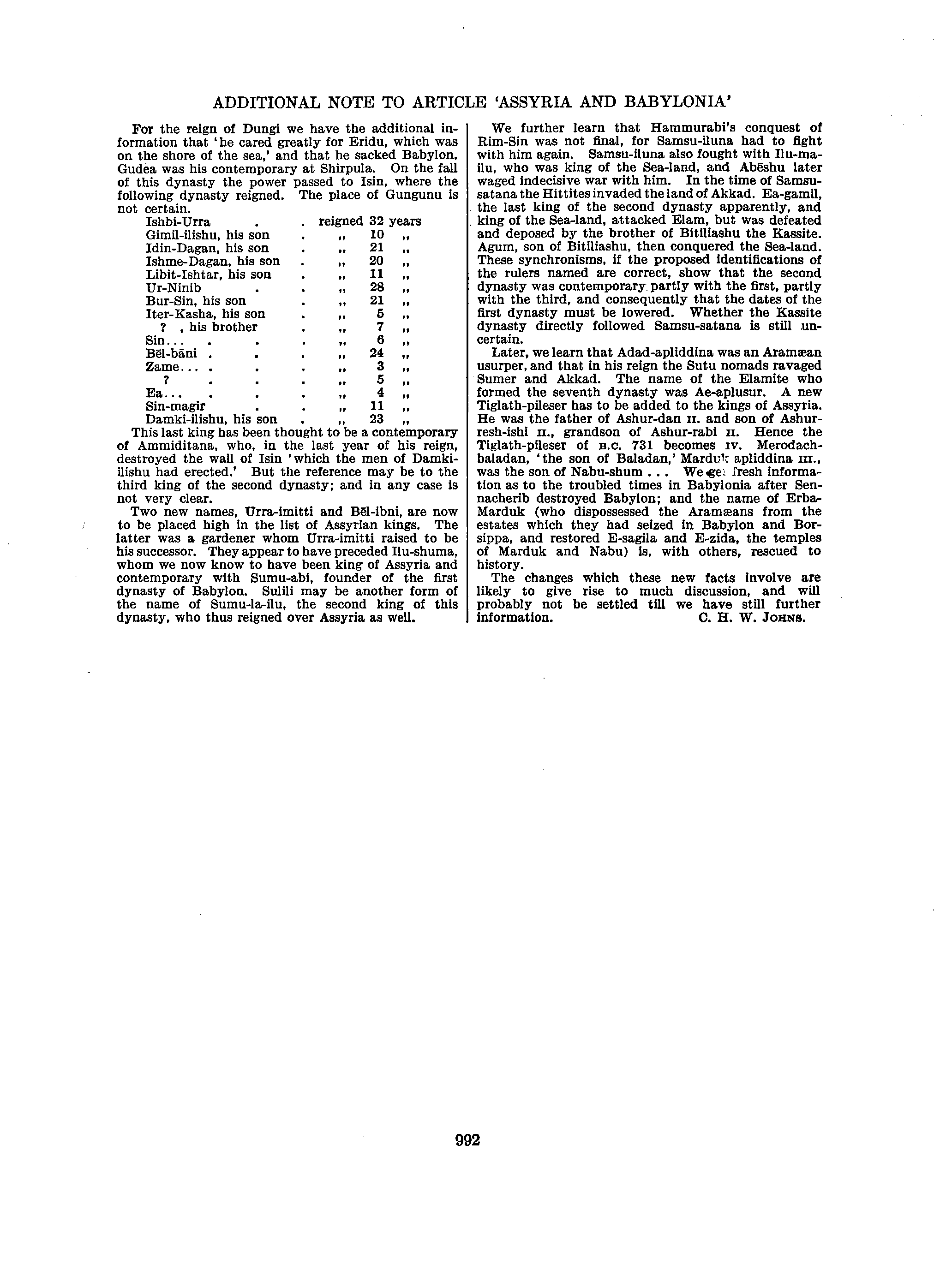ADDITIONAL
NOTE
TO
ARTICLE
'ASSYRIA
AND
BABYLONIA'
For
the
reign
of
Dungi
we
have
the
additional
in-formation
that
'he
cared
greatly
for
Eridu,
which
was
on
the
shore
of
the
sea,'
and
that
he
sacked
Babylon.
Gudea
was
his
contemporary
at
Shirpula.
On
the
fall
of
this
dynasty
the
power
passed
to
Isin,
where
the
following
dynasty
reigned.
The
place
of
Gungunu
is
not
certain.
This
last
king
has
been
thought
to
be
a
contemporary
of
Ammiditana,
who,
in
the
last
year
of
his
reign,
destroyed
the
wall
of
Isin
'which
the
men
of
Damki-ilishu
had
erected.'
But
the
reference
may
be
to
the
third
king
of
the
second
dynasty;
and
in
any
case
is
not
very
clear.
Two
new
names,
TTrra^imitti
and
BSl-ibni,
are
now
to
be
placed
high
in
the
list
of
Assyrian
kings.
The
latter
was
a
gardener
whom
Urra-imitti
raised
to
be
his
successor.
They
appear
to
have
preceded
Ilu-shuma,
whom
we
now
know
to
have
been
king
of
Assyria
and
contemporary
with
Sumu-abi,
founder
of
the
first
dynasty
of
Babylon.
Sulili
may
be
another
form
of
the
name
of
Sumu-la-ilu,
the
second
king
of
this
dynasty,
who
thus
reigned
over
Assyria
as
well.
We
further
learn
that
Hammurabi's
conquest
of
Rim-Sin
was
not
final,
for
Samsu-iluna
had
to
fight
with
him
again.
Samsu-iluna
also
fought
with
Ilu-ma-ilu,
who
was
king
of
the
Sea-land,
and
AbSshu
later
waged
indecisive
war
with
him.
In
the
time
of
Samsu-satana
the
Hittites
invaded
the
land
of
Akkad.
Ea-gamil,
the
last
king
of
the
second
dynasty
apparently,
and
king
of
the
Sea-land,
attacked
Elam,
but
was
defeated
and
deposed
by
the
brother
of
BitUiashu
the
Kassite.
Agum,
son
of
Bitiliashu,
then
conquered
the
Sea-land.
These
synchronisms,
if
the
proposed
Identifications
of
the
rulers
named
are
correct,
show
that
the
second
dynasty
was
contemporary
partly
with
the
first,
partly
with
the
third,
and
consequently
that
the
dates
of
the
first
dynasty
must
be
lowered.
Whether
the
Kassite
dynasty
directly
followed
Samsu-satana
is
still
un-certain.
Later,
we
learn
that
Adad-apliddlna
was
an
Aramaean
usurper,
and
that
in
his
reign
the
Sutu
nomads
ravaged
Sumer
and
Akkad.
The
name
of
the
Elamite
who
formed
the
seventh
dynasty
was
Ae-aplusur.
A
new
Tiglath-pileser
has
to
be
added
to
the
kings
of
Assyria.
He
was
the
father
of
Ashur-dan
ii.
and
son
of
Ashur-resh-ishi
ii.,
grandson
of
Ashur-rabi
n.
Hence
the
Tiglath-pileser
of
B.C.
731
becomes
iv.
Merodach-baladan,
'the
son
of
Baladan,'
Mardul^
apliddina
in.,
was
the
son
of
Nabu-shum
.
.
.
We«ei
fresh
informa-tion
as
to
the
troubled
times
in
Babylonia
after
Sen-nacherib
destroyed
Babylon;
and
the
name
of
Erba^
Marduk
(who
dispossessed
the
Aramseans
from
the
estates
which
they
had
seized
in
Babylon
and
Bor-sippa,
and
restored
E-sagila
and
E-zida,
the
temples
of
Marduk
and
Nabu)
is,
with
others,
rescued
to
history.
The
changes
which
these
new
facts
involve
are
likely
to
give
rise
to
much
discussion,
and
will
probably
not
be
settled
till
we
have
still
further
information.
C.
H.
W.
Johns.

